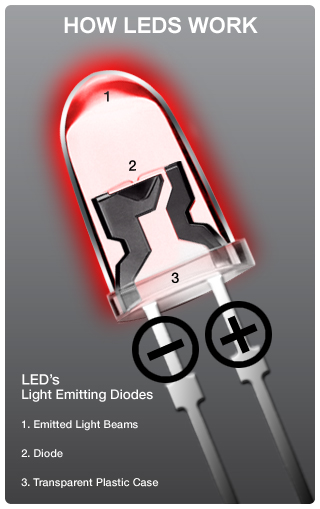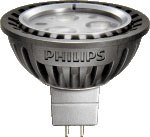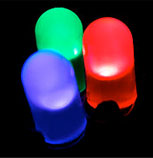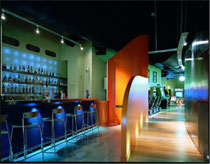LEDs
How it works
A Light Emitting Diode (LED) is a semiconductor diode that emits light when an electric current is applied in the forward direction of the device. The effect is a form of electroluminescence where incoherent and narrow-spectrum light is emitted from the p-n junction in a solid state material. LEDs do not require heating of a filament to create light. Instead, electricity is passed through a chemical compound (crystal) that is excited and generates light.

In the largest available light diodes their dimensions are represented by edges of only 1mm. LEDs thus belong to the smallest available, almost point-like, light sources.

An LED often has optics added directly on top of the chip to shape its radiation pattern and assist in reflection. The colour of the emitted light depends on the composition and condition of the semiconducting material used, and can be infrared, visible, or ultraviolet.

Colour LEDs
LEDs produce monochromatic radiation and their colour tone is defined by the dominant wavelength. There are LEDs in the colours red, orange, yellow, green and blue. The following table denotes the different semiconductor material used to achieve the various colours:
| Semiconductor material | Abbreviation | Colour |
| Aluminium-gallium arsenide | AlGaAs | red |
| Aluminium indium gallium phosphide | AlInGaP | red, orange, yellow |
| Gallium arsenide phosphide | GaAsP | red, orange, yellow |
| Indium gallium nitride | InGaN | green, blue |
White light can be produced as a mixture of all wavelengths, for example in LED modules. This arises through an additive mixture of the three RGB colours (Red, Green, Blue).
White LEDs
White light LEDs were developed by placing a phosphor compound on top of a blue LED. Here the light of a blue LED excites the luminescent material which changes a part of the blue light into yellow. By overlaying the unabsorbed blue light with yellow light emitted by the luminescent material white light is produced. The concentration of luminescent material needs to be guided precisely so that the desired white is realised. One of the biggest challenges has been to produce a stable 'white' light. Earlier and cheaper 'white' LEDs have often emit 'white' light with a blue tinge or hue.
Constant Colour White LEDs
For all the acknowledged benefits of power LEDs, such as efficiency, sustainability, and durability, the primary hurdle to be overcome is that of providing a supportable, high colour-quality supply of white LEDs. Leading LED maufacturers have recently formulated new phosphor technology which enables specific targeting for correlated colour temperature. This now puts the manufacturer in control of the colour temperature and tint and allows for production variance to be minimized. Until recently, consistency of LED selection has been via 'Binning', where each batch of LEDs is categorised so that the customer can ensure that exactly the same colour LEDs are used.
RGB LEDs
Red, Green, Blue (RGB) LEDs allow the designer, client or consumer the opportunity to produce a phenomenal array of lighting effects by blending different ratios of Red, Green or Blue.

Colour
Colour Rendering
The CIE have recently concluded that the current CRI method did not describe well those situations where white LED light sources were involved i.e. if white LED light sources were visually ranked together with other light sources. Low correlation was found between the visual colour differences and the computed colour differences if the current CRI method was applied to calculate those colour differences. The conclusion is that the CIE CRI is generally not applicable to predict the colour rendering rank order of a set of light sources when white LED light sources are involved in this set.
Using the CIE scale, warm white LEDs have a colour reproduction index from Ra ≥70 up to Ra ≥90. For cold white LEDs the Ra value is between 70 and 80.
Correlated Colour Temperature (CCT)
White LEDs are available in a range of Colour Temperatures. White LEDs have above all a cold, neutral white light with a colour temperature > 4,500 K. Further development in the area of convertible luminescent materials is making warmer light colours possible. Since 2003 there have been warm white (> 2,800 K) and neutral white (3,300 to 3,800 K) LEDs. For the domestic market, White LED lamps are offered in Warm White and Cool White.
Beam Angle (Optics)
As protection against environmental influences the semiconductor crystal is set into a housing. This is constructed so that the light radiates in a semicircle of almost 180 degrees (the current maximum is about 160 degrees). Guidance of the light is thus easier than in filament or discharge lamps, which generally radiate light in all directions. There are various types of housing for LEDs of low, medium and high performance; they all give good mechanical stability.
Dimming
There are several procedures for brightness control:
- Analogue dimming – where the LEDs are operated as a variable resistance

This procedure has two disadvantages: at low light intensity the control element has a relatively large performance loss which is converted into heat. Because of this a component for an appropriate diversion of the heat has to be included and this is of relatively large dimensions.
- Digital dimming - control with the aid of digitally controlled switches
Here the LEDs are switched on and off intermittently. This happens so often within one second that the eyes do not notice the flickering of the LED light. Control by pulse width modulation is, for example, such a process.
If the technique of brightness control is combined with the technological option of being able to set various coloured LEDs to individual colours, then colour sequences and plays of colour, as well as mixed colours, are very easily created.




